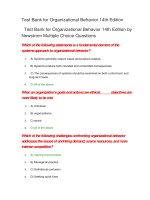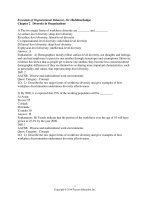Organizational behavior 14th by robbins 03
Bạn đang xem bản rút gọn của tài liệu. Xem và tải ngay bản đầy đủ của tài liệu tại đây (664.08 KB, 18 trang )
Robbins, Judge, and Vohra
Organizational Behavior
14th Edition
Attitudes
Attitudes and
and Job
Job Satisfaction
Satisfaction
Kelli J. Schutte
William Jewell College
Copyright © 2012 Dorling Kindersley (India) Pvt. Ltd
Authorized adaptation from the United States edition of Organizational
Behavior, 14e
3-1
Chapter
Chapter Learning
Learning Objectives
Objectives
After studying this chapter, you should be able to:
–
–
–
–
–
–
–
Contrast the three components of an attitude.
Summarize the relationship between attitudes and behavior.
Compare and contrast the major job attitudes.
Define job satisfaction and show how it can be measured.
Summarize the main causes of job satisfaction.
Identify four employee responses to dissatisfaction.
Show whether there are cultural differences in job
satisfaction.
Copyright © 2012 Dorling Kindersley (India) Pvt. Ltd
Authorized adaptation from the United States edition of Organizational
Behavior, 14e
3-2
Attitudes
Attitudes
Evaluative statements or judgments concerning objects,
people, or events
Three components of an attitude:
The opinion or
belief segment of
an attitude
The emotional or
feeling segment
of an attitude
An intention to
behave in a certain
way toward someone
or something
See E X H I B I T 3–1
See E X H I B I T 3–1
Copyright © 2012 Dorling Kindersley (India) Pvt. Ltd
Authorized adaptation from the United States edition of Organizational
Behavior, 14e
3-3
Does
DoesBehavior
BehaviorAlways
AlwaysFollow
Followfrom
fromAttitudes?
Attitudes?
Leon Festinger – No, the reverse is sometimes true!
Cognitive Dissonance: Any incompatibility between two
or more attitudes or between behavior and attitudes
– Individuals seek to reduce this uncomfortable gap, or
dissonance, to reach stability and consistency
– Consistency is achieved by changing the attitudes, modifying
the behaviors, or through rationalization
– Desire to reduce dissonance depends on:
• Importance of elements
• Degree of individual influence
• Rewards involved in dissonance
Copyright © 2012 Dorling Kindersley (India) Pvt. Ltd
Authorized adaptation from the United States edition of Organizational
Behavior, 14e
3-4
Moderating
Moderating Variables
Variables
The most powerful moderators of the attitudebehavior relationship are:
–
–
–
–
–
Importance of the attitude
Correspondence to behavior
Accessibility
Existence of social pressures
Personal and direct experience of the attitude
Copyright © 2012 Dorling Kindersley (India) Pvt. Ltd
Authorized adaptation from the United States edition of Organizational
Behavior, 14e
3-5
Predicting
Predicting Behavior
Behavior from
from Attitudes
Attitudes
– Important attitudes have a strong relationship to
behavior.
– The closer the match between attitude and
behavior, the stronger the relationship:
• Specific attitudes predict specific behavior
• General attitudes predict general behavior
– The more frequently expressed an attitude, the
better predictor it is.
– High social pressures reduce the relationship and
may cause dissonance.
– Attitudes based on personal experience are
stronger predictors.
Copyright © 2012 Dorling Kindersley (India) Pvt. Ltd
Authorized adaptation from the United States edition of Organizational
Behavior, 14e
3-6
What
What are
are the
the Major
Major Job
Job Attitudes?
Attitudes?
Job Satisfaction
– A positive feeling about the job
resulting from an evaluation of its
characteristics
Job Involvement
– Degree of psychological identification
with the job where perceived
performance is important to selfworth
Psychological Empowerment
– Belief in the degree of influence over
the job, competence, job
meaningfulness, and autonomy
Copyright © 2012 Dorling Kindersley (India) Pvt. Ltd
Authorized adaptation from the United States edition of Organizational
Behavior, 14e
3-7
Another
Another Major
Major Job
Job Attitude
Attitude
Organizational Commitment
– Identifying with a particular organization and its goals, while
wishing to maintain membership in the organization.
– Three dimensions:
• Affective – emotional attachment to organization
• Continuance Commitment – economic value of staying
• Normative – moral or ethical obligations
– Has some relation to performance, especially for new
employees.
– Less important now than in the past – now perhaps more of
an occupational commitment, loyalty to profession rather
than a given employer.
Copyright © 2012 Dorling Kindersley (India) Pvt. Ltd
Authorized adaptation from the United States edition of Organizational
Behavior, 14e
3-8
And
And Yet
Yet More
More Major
Major Job
Job Attitudes…
Attitudes…
Perceived Organizational Support (POS)
– Degree to which employees believe the organization values
their contribution and cares about their well-being.
– Higher when rewards are fair, employees are involved in
decision making, and supervisors are seen as supportive.
– High POS is related to higher OCBs and performance.
Employee Engagement
– The degree of involvement with, satisfaction with, and
enthusiasm for the job.
– Engaged employees are passionate about their work and
company.
Copyright © 2012 Dorling Kindersley (India) Pvt. Ltd
Authorized adaptation from the United States edition of Organizational
Behavior, 14e
3-9
Are
Are These
These Job
Job Attitudes
Attitudes Really
Really Distinct?
Distinct?
No: these attitudes are
highly related.
Variables may be
redundant (measuring
the same thing under a
different name)
While there is some
distinction, there is also
a lot of overlap.
Be patient, OB researchers are working on it!
Copyright © 2012 Dorling Kindersley (India) Pvt. Ltd
Authorized adaptation from the United States edition of Organizational
Behavior, 14e
3-10
Job
Job Satisfaction
Satisfaction
One of the primary job attitudes measured.
– Broad term involving a complex individual summation of a
number of discrete job elements.
How to measure?
– Single global rating (one question/one answer)
– Summation score (many questions/one average)
Are people satisfied in their jobs?
–
–
–
–
In India, yes. Seventy-one percent of Indian employees
surveyed are satisfied with their jobs.
Results vary by employee facets of the job.
Compensation, benefits, and incentives are the most
problematic elements in India.
See E X H I B I T 3–2
See E X H I B I T 3–2
Copyright © 2012 Dorling Kindersley (India) Pvt. Ltd
Authorized adaptation from the United States edition of Organizational
Behavior, 14e
3-11
Causes
Causes of
of Job
Job Satisfaction
Satisfaction
Pay influences job satisfaction only to a point.
– Once an individual reaches a comfortable level of living, there
is no relationship between amount of pay and job satisfaction.
– Money may bring happiness, but not necessarily job
satisfaction.
Personality can influence job satisfaction.
– Negative people are usually not satisfied with their jobs.
– Those with positive core self-evaluation are more satisfied
with their jobs.
See E X H I B I T 3–3
See E X H I B I T 3–3
Copyright © 2012 Dorling Kindersley (India) Pvt. Ltd
Authorized adaptation from the United States edition of Organizational
Behavior, 14e
3-12
Employee
Employee Responses
Responses to
to Dissatisfaction
Dissatisfaction
Active
Destructive
Constructive
Passive
See E X H I B I T 3–4
See E X H I B I T 3–4
Copyright © 2012 Dorling Kindersley (India) Pvt. Ltd
Authorized adaptation from the United States edition of Organizational
Behavior, 14e
3-13
Outcomes
Outcomes of
of Job
Job Satisfaction
Satisfaction
Job Performance
– Satisfied workers are more productive AND more
productive workers are more satisfied!
– The causality may run both ways.
Organizational Citizenship Behaviors
– Satisfaction influences OCB through perceptions of
fairness.
Customer Satisfaction
– Satisfied frontline employees increase customer
satisfaction and loyalty.
Absenteeism
– Satisfied employees are moderately less likely to miss
work.
Copyright © 2012 Dorling Kindersley (India) Pvt. Ltd
Authorized adaptation from the United States edition of Organizational
Behavior, 14e
3-14
More
More Outcomes
Outcomes of
of Job
Job Satisfaction
Satisfaction
Turnover
– Satisfied employees are less likely to quit.
– Many moderating variables in this relationship.
• Economic environment and tenure
• Organizational actions taken to retain high performers and to
weed out lower performers
Workplace Deviance
– Dissatisfied workers are more likely to unionize, abuse
substances, steal, be tardy, and withdraw.
Despite the overwhelming evidence of the impact of job
satisfaction on the bottom line, most managers are either
unconcerned about or overestimate worker satisfaction.
Copyright © 2012 Dorling Kindersley (India) Pvt. Ltd
Authorized adaptation from the United States edition of Organizational
Behavior, 14e
3-15
Global
Global Implications
Implications
Are Employees in Some Cultures More Satisfied With
Their Jobs?
– According to some studies, Western workers appear to be
more satisfied than those in Eastern cultures. This may be
because Westerners emphasize positive emotions and
individual happiness more than do those in Eastern cultures.
– Another study showed that Indian employees rated their
satisfaction higher than other employees in the Asia-Pacific
region.
See E X H I B I T 3–5
See E X H I B I T 3–5
Copyright © 2012 Dorling Kindersley (India) Pvt. Ltd
Authorized adaptation from the United States edition of Organizational
Behavior, 14e
3-16
Summary
Summary and
and Managerial
Managerial Implications
Implications
Managers should watch employee attitudes:
– They give warnings of potential problems
– They influence behavior
Managers should try to increase job satisfaction and
generate positive job attitudes
– Reduces costs by lowering turnover, absenteeism, tardiness,
theft, and increasing OCB
Focus on the intrinsic parts of the job: make work
challenging and interesting
– Pay is not enough
Copyright © 2012 Dorling Kindersley (India) Pvt. Ltd
Authorized adaptation from the United States edition of Organizational
Behavior, 14e
3-17
All rights reserved. No part of this publication may be reproduced,
stored in a retrieval system, or transmitted, in any form or by any
means, electronic, mechanical, photocopying, recording, or otherwise,
without the prior written permission of the publisher. Printed in the
United States of America.
Copyright ©2011 Pearson Education, Inc.
Publishing as Prentice Hall
3-18









